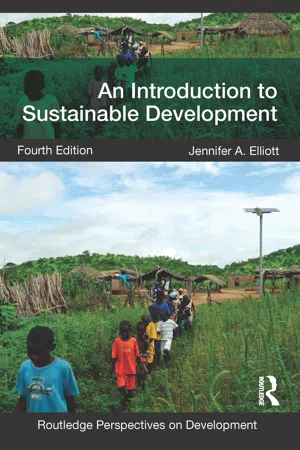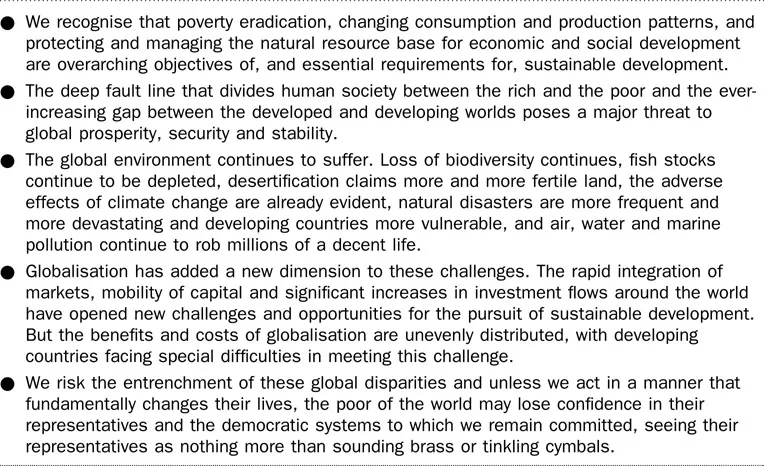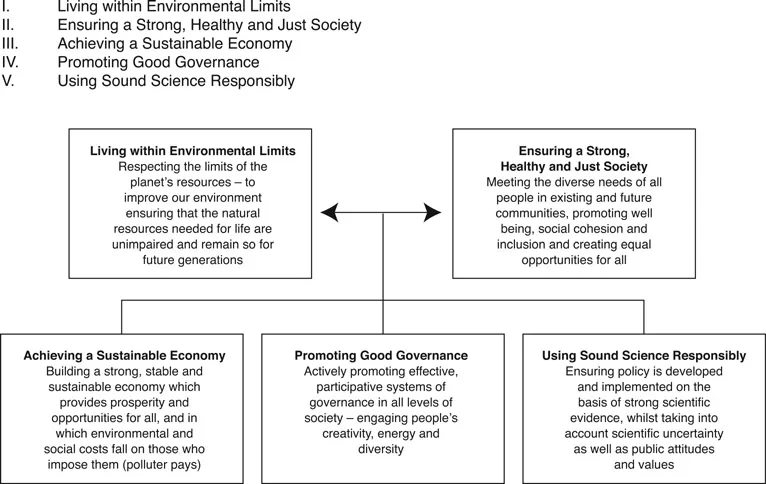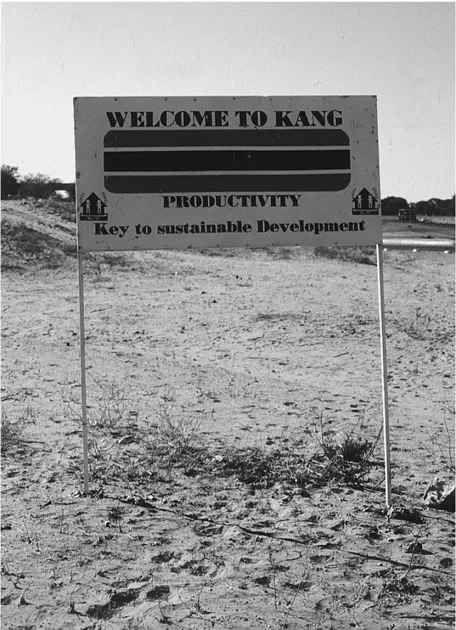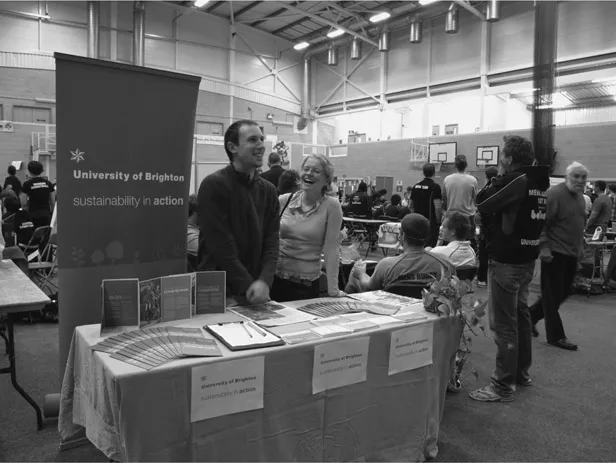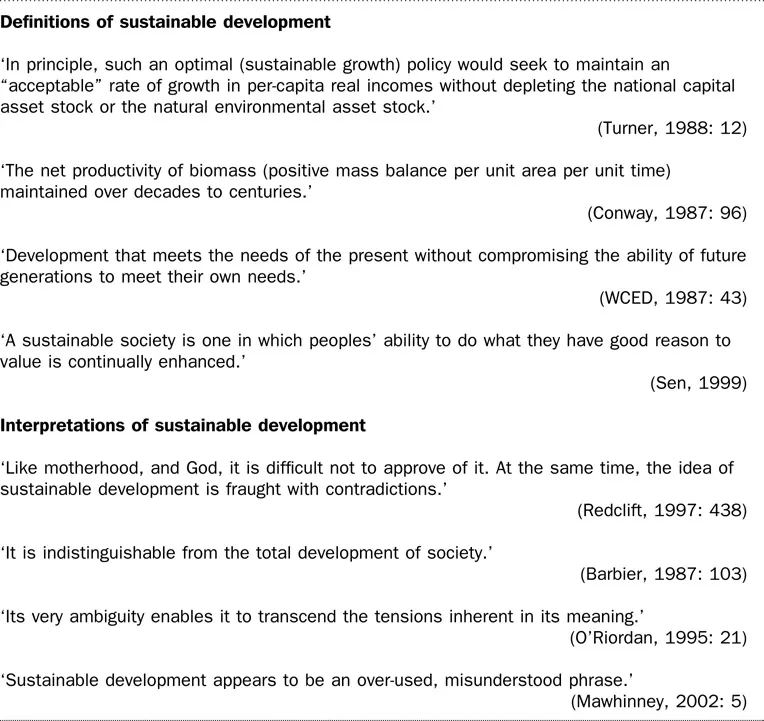Introduction
In 1984, the United Nations (UN) established an independent group of 22 people drawn from member states of both the developing and developed worlds, and charged them with identifying long-term environmental strategies for the international community. The report of the World Commission on Environment and Development entitled Our Common Future (WCED, 1987) is widely considered to have been key in putting sustainable development firmly into the political arena of international development thinking. It used the term ‘sustainable development’ extensively and defined it as ‘Development that meets the needs of the present without compromising the ability of future generations to meet their own needs’ (p. 43). The report has been translated into more than 24 languages (Finger, 1994) and its definition of the term continues to be that which is most widely used and cited. For the first time, the Commission had considered environmental concerns arising through development processes from an economic, social and political perspective rather than solely from a science base as in previous studies. Their recommendations focused on integrating development strategies and environmental policies and global partnerships to meet the interdependent environmental concerns and development opportunities North and South.
The work of the commission was undertaken as the basis for a UN conference on Environment and Development to be held five years later. The ‘Earth Summit’ in Rio de Janeiro, Brazil in 1992 was, at the time, the largest ever international conference held. It was also the first time heads of state had gathered to consider the environment. One hundred and sixteen heads of state or governments and over 8,000 delegates attended. A further 3,000 non-governmental organisations (NGOs) took part in parallel fora (Adams, 2009). The central aim was to identify the principles of an agenda for action towards sustainable development in the future and the challenge was seen to require consensus at the highest level. A key outcome was the ‘Agenda 21’ document (extending to 40 chapters and 600 pages) detailing the issues, the actors and the means for achieving sustainable development by the start of the twenty-first century. Putting sustainable development into practice was seen to involve the participation of a full range of sectors, groups and organisations; in business and science, youth and church groups within communities and by local authorities as well as international agencies as seen in Figure 1.1. A number of important international conventions were also agreed at Rio, including the Convention on Biodiversity and the Framework Convention on Climate Change in recognition of the growing problems of sustainable use of ecosystems and of human-induced climate change. There was an optimism concerning a common interest on behalf of countries globally and between current and future generations that would drive sustainable development into practice.
Ten years later, 104 heads of state gathered again for the UN World Summit on Sustainable Development (WSSD) in Johannesburg, South Africa. The aim was to reinvigorate at the highest political level, the global commitment to a North–South partnership to achieve sustainable development. It has been referred to as ‘by far the most inclusive summit to date’ (Seyfang, 2003: 227) for the way in which more stakeholder groups were brought into formal meetings, including a bigger presence for business and many more NGOs from the developing world, representing issues of human rights, social justice and business accountability, for example. These activities suggested new ways of addressing sustainable development at a global level and a ‘more decentralized understanding of where change comes from’ (Bigg, 2004: 5). There was a new understanding of the complex interdependencies of environmental, social and economic development (Potter et al., 2008) and of the difficult political challenges of sustainable development. Key concerns at the start of the twenty-first century were for the continued degradation of environmental systems since Rio, but also for the persistence of poverty and evidence of widening global disparities.
Figure 1.1 The structure of Agenda 21
In 2000, the UN community had committed to the achievement of eight Millennium Development Goals (MDGs) embracing many of these concerns. One of these goals refers explicitly to sustainable development and the actions of governments in preparing national sustainable development strategies, for example. Many others are central to sustainable development in that they demand better outcomes in the arenas that affect poorer groups. Figure 1.2 identifies the MDG goals, the specific targets set and the principal ways in which they link explicitly to the environment. However, at the WSSD, a central concern was the impacts of ‘globalisation’ on the poor. In short, whilst people and places were becoming more closely linked together within global markets and through flows of finance, for example, the benefits and costs of economic globalisation were not being shared equally across or within countries. Poverty, inequality and exclusion were identified as threats not just to the environment and economic prosperity but also to future security and democracy. Whereas globalisation had not been discussed at the Rio conference, a decade later it was central to understanding sustainable development as seen in the Johannesburg Declaration (Figure 1.3).
A further UN summit, ‘Rio+20’ is currently planned for 2012 to be held again in Brazil. All stakeholders have been invited not just to the conference, but to contribute in advance to a working document that will inform what is discussed and the official outcome documents. The aim of the conference is to secure renewed political commitment for sustainable development, to assess progress on the outcomes of previous summits and to address new and emerging challenges for the global community. Two themes are considered priorities: the challenges of moving to a ‘green economy’ and what the future institutional framework for sustainable development should be. What these challenges entail and how they have emerged is the focus of the next two chapters. In short, a number of crises are facing the world – of climate, economy, food and energy, and poverty for example – that are now understood as interlinked. The notion of the green economy seeks an economic system that can address and prevent these crises whilst also protecting the earth’s ecosystems, provide economic growth and contribute to poverty alleviation. Questions of the future institutional framework for sustainable development include whether the formal organisations (including those within the UN) are ‘fit for purpose’ to guide, monitor and coordinate progress towards sustainable development in future. They also embrace many wider issues of ‘governance’ that confirm the important role across all scales, not only of governments, but also private business and civil society organisations in shaping the prospects for sustainable development. They also question the principles on which decisions are made, whether these are equitable and participatory, for example.
Evidently, sustainable development is considered a central and important challenge for international organisations such as the United Nations and for governments worldwide. It is seen to embrace linked
Figure 1.2 The Millennium Development Goals and the environment
Figure 1.3 The Johannesburg Declaration on Sustainable Development: the challenges we face
concerns for environmental degradation, poverty and exclusion currently and regarding the long-term viability of existing approaches in both environment and development. Figure 1.4 identifies the principles of sustainable development identified by the UK government. However, sustainable development is a term that has currency well beyond international organisations and heads of state, even becoming ‘hard to avoid’ (Gibson, 2005). It has been taken up extensively by a range of organisations and interests and is a term widely used in the media and across academic disciplines, for example. It is used to sell products, justify policy decisions and inspire action. For some, the term ‘sustainable development’ has been redefined so many times and used to cover so many aspects of society–environment relationships that there are ‘doubts on whether anything good can ever be agreed’ (Mawhinney, 2002: 1). For others, sustainable development is an idea that ‘makes a difference’ precisely because it requires debate and resolution of different interests and because it challenges both researchers and policy-makers alike (McNeill, 2000).
This chapter considers how and why sustainable development has become such a widespread but also contested notion. It identifies a number of different ‘meanings’ within different disciplinary perspectives and considers changing ideas about how development can best be achieved and the actions required to manage environmental change. Identifying these changes in thinking and practice from which the notion of sustainable development has emerged is central to understanding the nature of current challenges and actions for sustainable development (the focus of Chapters 2 and 3 respectively).
Figure 1.4 The UK Government’s Principles of Sustainable Development
The concept of sustainable development
Literally, sustainable development refers to maintaining development over time. However, there are possibly hundreds of definitions of the term currently in circulation, many divergent interpretations and thousands of variations applied in practice (Gibson, 2005). Figure 1.5 lists just a small number of such definitions and the varied interpretations of the concept. Definitions are important, as they are the basis on which the means (strategies, policies and mechanisms) for achieving sustainable development are built: how the human and environmental ‘condition’ is thought about, viewed or understood underpins subsequent interventions. As will be seen in this section,
Plate 1.1 Promoting the messages of sustainable development
a. Sign on entry to Kang, Botswana
b. Fresher’s Fair, University of Brighton, England
different disciplines have influenced and contributed to the sustainability debate, ‘each making different assumptions about the relation between environment and the human subject’ (Lee et al., 2000: 9) and assigning to it quite divergent orders of priority and recommendations in terms of policies, programmes and projects. Throughout this text, it will be apparent that although there are many shared concerns for, emerging principles of and evidence of progress towards sustainable development, there is also much uncertainty and contestation regarding how to best promote sustainable change and concerning the impacts of policies and mechanisms taken towards sustainable development.
Figure 1.5 Defining and interpreting the contested concept of sustainable development
As suggested in the quotations in Figure 1.5, the attractiveness of the concept of sustainable development may lie precisely in the varied ways in which it can be interpreted, enabling diverse and possibly incompatible interests to ‘sign up to’ sustainable development and to support a wide range of practical initiatives and causes. This is what is termed ‘constructive ambiguity’ in understanding the concept that enables a ‘strategic flexibility’ in terms of responses. However, it also confirms the need for ongoing critical consideration of whose values and interests are encompassed in particular kinds of policy and practical intervention and who may suffer costs and losses, that is, it is more than an academic debate. As Jacobs (1991) identified, sustainable development is a ‘contestable concept’, that like ‘democracy’ or ‘equality’ has a basic meaning that almost everyone is in favour of, but there are deep conflicts around how they should be understood and fostered.
Sustainable development as ‘common sense’?
The challenges of understanding what the idea of sustainable development may mean, and what it entails in practice is evident in an analysis of the apparently simple definition provided by the WCED in 1987 (identified above in Figure 1.5). Common sense could suggest that development today should not be at the expense of future generations, but what is it that one generation is passing to another? Is ...
